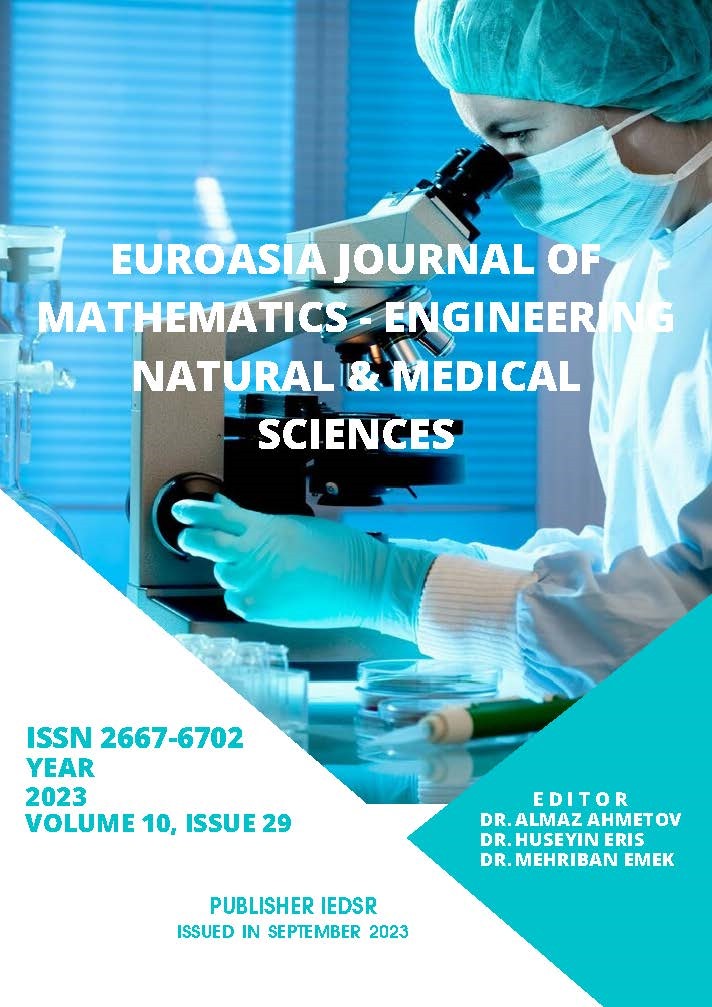Çevre Dostu Uçucu Kül Tabanlı Geopolimer Tuğlalara Yüksek Fırın Cürufunun Etkisi
DOI:
https://doi.org/10.5281/zenodo.8418240Anahtar Kelimeler:
Jeopolimer tuğla, yüksek fırın cürufu, uçucu kül, sodyum hidroksit, kalsiyum hidroksitÖzet
Bu çalışmada Karabük Demir Çelik Fabrikası atığı olan yüksek fırın cürufu ve Seyitömer termik santrali atık uçucu külü kullanılarak uçucu kül bazlı geopolimer tuğlaların üretilmesi hedeflenmektedir. Çalışmada normal tuğlalara göre üstün fiziksel ve mekanik özelliklere sahip, ısıl özellikleri daha iyi olan bir geopolimer tuğla üretilmesi amaçlanmaktadır. Bu amaç doğrultusunda, uçucu kül (%20) ve farklı oranlarda (%10, %30, %50 ve %70) yüksek fırın cürufu ve 8 - 10 M sodyum hidroksit ve %4 - 8 kalsiyum hidroksit konsantrasyonları esas alınarak geopolimer tuğlalar üretilmiştir. Numuneler birim hacim ağırlığı, su emme (ağırlıkça), basınç dayanımı ve eğilmede çekme dayanımı testlerine tabi tutulmuştur. Mikroyapı analizi için numunelerin SEM görüntüleri alınmıştır. Çalışma sonucunda sodyum hidroksit ve kalsiyum hidroksit oranının artmasıyla daha amorf bir yapı elde edildiği, su emme miktarının azaldığı ve basınç dayanımının arttığı belirlenmiştir. Ayrıca atık bertarafı için çok uygun bir yöntem olan geopolimer tuğla üretiminde atıkların kullanılabileceği belirlenmiştir.
Referanslar
Rahman, ME., Ong, PJ., Nabinejad, O., Islam, S., Khandoker NAN., Pakrashi, V. and Shorowordi, KM. (2018). Utilization of blended waste materials in bricks, Technologies, 6 (20), 1-12.
Houben, H., Guillaud, H. (1994) Earth construction: A Comprehensive Guide, London.
Pancheti, J., Mahen Mahendran (2023). Fire resistance of external light gauge steel framed walls with brick veneer cladding, Thin-Walled Structure, 182 (2023) 110162.
Niroumand, H., Zain, MFM., Alhosseini, SN. (2013) The influence of nano-clays on compressive strength of earth bricks as sustainable materials, Procedia –Social and Behavioral Sciences, (89), 862–865.
Shakir, AA., Naganathan, SK., Mustapha, KNB. (2013). Development Of Bricks From Waste Material: A Review Paper. Australian Journal of Basic and Applied Sciences, 7(8), 812-818.
Tchadjié, L.N., Djobo, J.N.Y., Ranjbar, N., et al., (2016). Potential of using granite waste as raw material for geopolymer synthesis, Ceramics International, 42 (2016), 3046-3055.
Sithole, N.T., Mashifana, T. (2020). Geosynthesis of building and construction materials through alkaline activation of granulated blast furnace slag, Construction and Building Materials, 264 (2020), 120712.
Sithole, T., Mashifana, T., Mahlangu, D., Tchadjié, L. (2023). Effect of binary combination of waste gypsum and fly ash to produce building bricks, Sustainable Chemistry and Pharmacy, 31, April 2023, 100913.
Erdoğdu, Ş., Kurbetci, Ş. (2003). Chemical and mineral additives in terms of the effectiveness they provide to the performance of concrete. Türkiye Engineering News, 426(4), 115-120.
Uysal, F.F., Bahar, S. (2018). Slag types and usage areas. Trakya University Journal of Engineering Sciences, 19(1), 37-52.
Tokyay, M., Erdoğdu, K. (1997). Slags and slag cements.TÇMB/AR-GE/Y97.2, Ankara
Koçak, B., Şahin, Y.İ., Koçak Y., (2023). Estimation of the Effect of Blast Furnace Slag on the Flexural Strength of Portland Cement by Fuzzy Logic and ANFIS, Journal of ESTUDAM Information, 4(1), 17-24.
Çağlar, H., Çağlar, A., (2019) Research of Physical and Mechanical Properties of Blended Bricks with Fly Ash Based Blast Furnace Slag Addition, International Journal of Research –Granthaalayah, 1–10.
Ay, D., (2022). Determination of Fly Ash Characterization of Çanakkale Province Thermal Power Plants, Master Thesis, Çanakkale Onsekiz Mart University Graduate Education Institute.
Web iletti 1. https://emboykimya.com.tr/urunler/kalsiyum-hidroksit/. Date of access: 20.12.2022
Abdullah, M.M.A., Ibrahim, W.M.W., Tahir, M.F.M., (2015). The properties and durability of fly ash-based geopolymeric masonry bricks, in: F. Pacheco-Torgal, P.B. Lourenço, J.A. Labrincha, S. Kumar, P.B.T.-E.-E.M.B. and B. Chindaprasirt (Eds.), Woodhead Publishing, Oxford.
Zawrah, M.F., Gado, R.A., Feltin, N., Ducourtieux, S., Devoille, L., (2016). Recycling and utilization assessment of waste fired clay bricks (Grog) with granulated blast furnace slag for geopolymer production, Process Safety and Environmental Protection, 103, 237–251.
Venugopal, K., Radhakrishna, M., Sasalatti, V., (2016). Development of Alkali Activated Geopolymer Masonry Blocks, IOP Conference Series: Materials Science and Engineering, 149 (2016), 12072.
Apithanyasai, S., Nooaek, P., Supakata, N., (2018) The Utilization of Concrete Residue with Electric Arc Furnace Slag in the Production of Geopolymer Bricks, Engineering Journal, 22 (2018), 1–14.
TS 699, (2000), Natural building blocks-Examination and test methods, Turkish Standards Institute, Ankara.
TS EN 772,1, (2012), “Methods of test for masonry units- Part 1: Determination of compressive strength”, Turkish Standardization Institute, Ankara.
TS EN 772-6, (2004). Masonry units - Test methods - Part 6: Determination of flexural tensile strength of concrete masonry units, Turkish Standardization Institute, Ankara.
TS 705, (1985). Solid Bricks and Vertically Perforated Bricks, Turkish Standardization Institute, Ankara.
Sudhir, M.R., Beulah, M., Rai, R. S., Gayathri, G. (2021). Materials Today: Proceedings, 46(2021), 163-169.
Madani, H., Ramezanianpour, A.A., Shahbazinia, M., Ahmadi, E. (2020). Geopolymer bricks made from less active waste materials, Construction and Building Materials, 247(2020), 118441.
Sürül, O. (2015). Investigation of the Use of Blast Furnace Slag and Fly Ash as Additives in Brick Production. Master Thesis, Bulent Ecevit University, Institute of Science and Technology. Zonguldak.
ASTM C62-10 (2010). Standard Specification For Building Brick (Solid Masonry Units Made From Clay Or Shale), American Society for Testing and Materials (ASTM), USA.
İndir
Yayınlanmış
Nasıl Atıf Yapılır
Sayı
Bölüm
Lisans
Telif Hakkı (c) 2023 Euroasia Journal of Mathematics, Engineering, Natural & Medical Sciences

Bu çalışma Creative Commons Attribution-NonCommercial 4.0 International License ile lisanslanmıştır.

